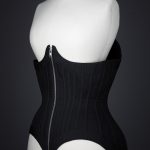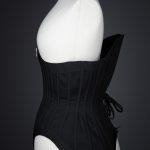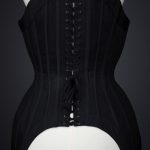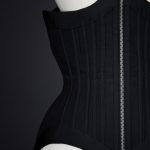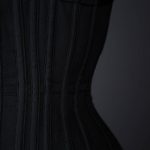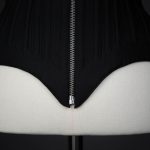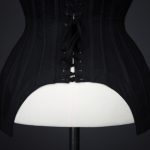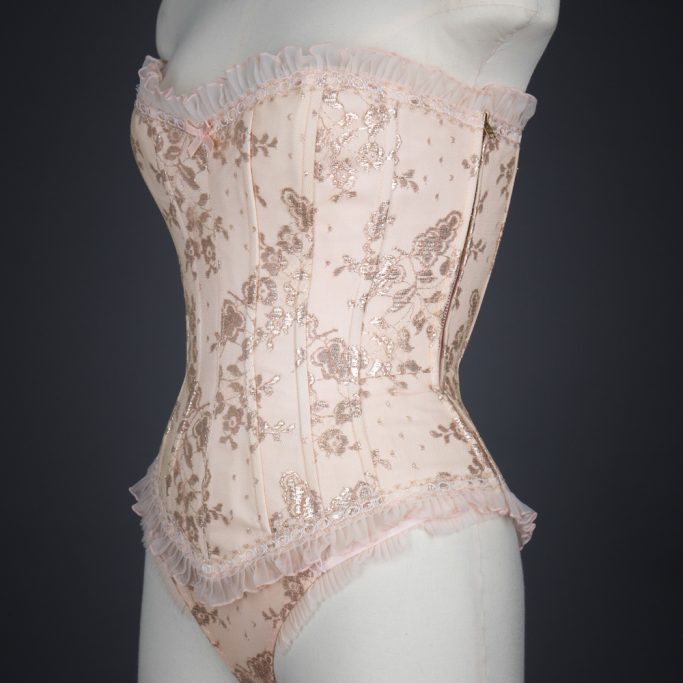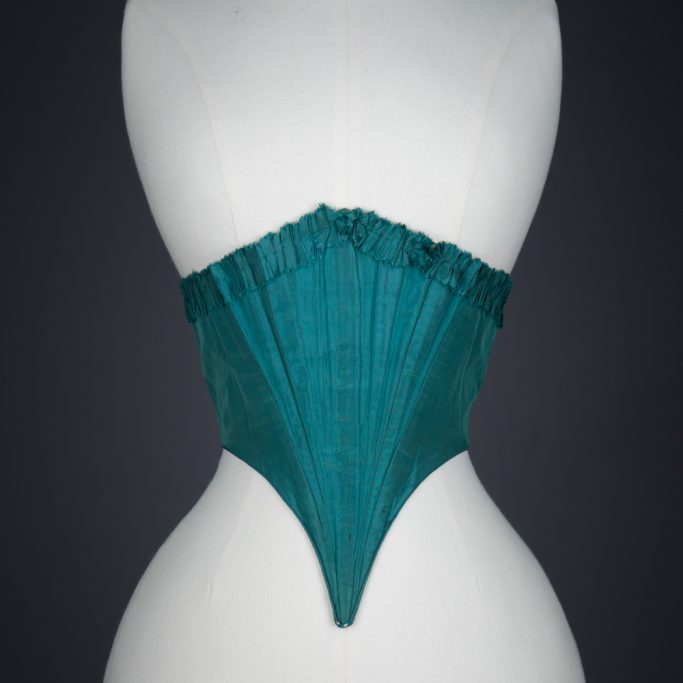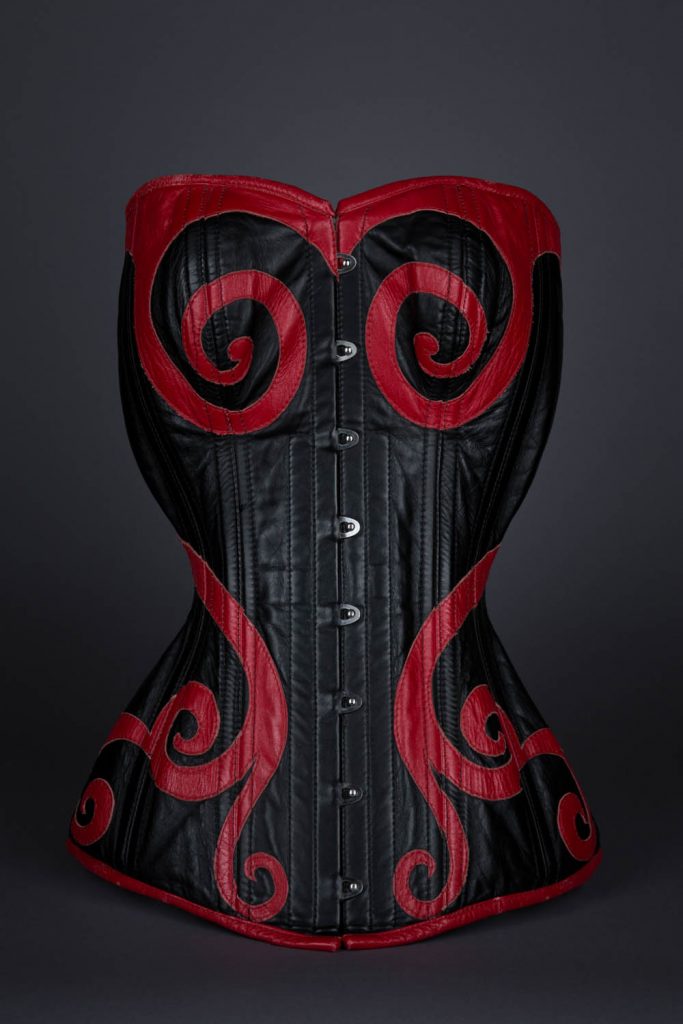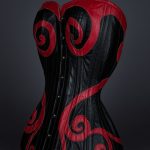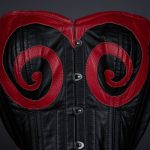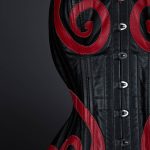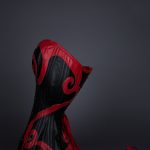With all undergarments now essentially seen as optional in contemporary society, the corset in particular has enjoyed many opportunities for reinvention. One of its facets is a return to its roots in the form of body modification. Though corsets are no longer required to create a certain silhouette under clothing, a new crowd of waist trainers and tightlacers feature corsetry as an integral part of their personal image. The aesthetic of tightlacing is often sleek and pared down for “training” corsets, worn under the clothes (“stealthing”), while the frequency of wear creates an excuse to invest in show pieces. Though corsets had occasionally been seen as outerwear before the aughts, the freedom and variety of dress in the 21st century opened the gates for a widespread acceptance and array of styling options.
Chapter 4: Corsets As Body Modification
'Black Moon' Underbust Corset By Grace Horne
Date: 2017
Origin: United Kingdom
Fabric: Cotton coutil with silk trim
Brand: Grace Horne
This corset was an exercise in pared down elegance. With a single coutil layer construction and same colour silk trim for bone channels and facings, it relies entirely on the differences in the two fabrics to add interest. The smooth, extra-wide facings on the top and bottom edges provide enough area for the sheen of the silk to be appreciated.
Modern corsetry gives me a framework in which to explore ideas. Often my creativity is driven by the technical challenges of what a corset needs to work well and how the material that I have selected for a project requires new solutions. I can get quite obsessed with the details of construction and it’s a field that rewards such an approach. The precision that is required in corset making feels like engineering but with the added complication of having to work on a moving human body.
– Grace Horne, 2017
When worn as outerwear the corset doesn’t need to be concealed. It can use non-traditional materials such as bold zips and leather. Contemporary clothing is rarely built to be worn over foundationwear, so an exterior corset can cinch the waist and dramatically alter the original silhouette.
Peach Nylon With Metallic Lace Overlay Corset & Thong by Fifi Chachnil
Date: Autumn/Winter 1998
Origin: France
Fabric: Nylon
Brand: Fifi Chachnil
A corset and thong set by Parisian designer Fifi Chachnil. Both garments are constructed of a mix of peach nylon mesh and lurex thread lace. The corset is a ‘fashion’ corset rather than a functional piece of shapewear. It is lightly structured with plastic boning and fastens with a metal zip on the side seam. The back lacing is mostly decorative and uses pre-made eye tape for the lacing to loop through. The ribbon lacing this corset is shown with is not part of the original garment. The thong is edged with plush elastic and features an elastane blend mesh in the back and side panels for a more flexible fit. Both pieces are trimmed with pleated nylon ruffles.
Designer Fifi Chachnil launched her first collection of ready-to-wear in 1984, before specialising in lingerie from 1996. The label is characterised by its frivolous, feminine and quintessentially Parisian aesthetic, often inspired by showgirls and musicals. Products are all sewn in a Parisian atelier from premium fabrics such as leavers laces and silks.
Green Silk swiss Waist With Ruffled Trim
Date: c. 1860s
Origin: United States
Fabric: Silk
Brand: Custom made
The term ‘Swiss Waist’ refers to a boned, typically pointed cincher or corselet, initially popularised in the 1860s and later returning as a trend in the 1880-1890s. This garment is not actually a piece of underwear, but was worn over skirts, blouses and dresses to accentuate the waistline. In many ways, this style was a precursor to wearing the corset as a piece of outerwear.
This example is created with an outer layer of green silk and a cotton lining, trimmed with pinked and ruffle silk trim at the underbust. It fastens with lacing and hand sewn eyelets at the centre back. It is mostly machine sewn, with notably small stitches, and hand finished on the interior seams and trims.
SWEETHEART VICTORIAN CORSET FOR CATHIE JUNG BY DARK GARDEN
Date: 1996
Origin: San Francisco CA, United States
Fabric: Black leather, red leather appliqué, poplin lining
Brand: Dark Garden
Designer: Autumn Adamme
Cathie Jung (the Guinness World Record holder for the smallest waist on a living person) wanted a red and black leather corset that accentuated the smallness of her trained waist. Autumn Adamme created the red design after completing Cathie’s pattern. All of the appliqué needed to match at every part of the seam. The greatest challenge was accommodating her very trained waist as well as attempting to create a flat abdomen without using a spoon busk or excessively rigid steels. Dark Garden created two prototypes, fitting Cathie in person. The finished corset has a closed 16″ waist.
Autumn Adamme created her first corset in 1983 at the age of 12, and founded Dark Garden in 1989. Since the mid-90s, she’s been the preferred corsetiere for burlesque superstar Dita Von Teese, who wore a Dark Garden corset on the cover of Playboy in 2002. For her contributions to the resurgence of corsets in the 20th century, she’s been dubbed the Godmother of Modern Corsetry and is one of but a few makers from that era who is still creating. Dark Garden is one of the most venerated corsetry houses, employing roughly half a dozen artisans to create hundreds of corsets each year. 2015 and 2016 saw a cross-continental cameo collaboration between Autumn and the famed Mister Pearl.
Corsetry has always been a part of fashion, supporting the current fashionable silhouette in addition to accommodating the figure of the wearer. When I started making corsets for fashion, rather than to recreate historical silhouettes, I took into account modern bodies and this informed my pattern shapes. We make corsets for every purpose and from an amazing array of materials now.
– Autumn Adamme, 2017
The Underpinnings Museum relies on your generous support to continue its work. If you’ve enjoyed visiting the website, please consider donating to The Underpinnings Museum or purchasing some merchandise. All funds are invested directly back into the project to bring you more free access underwear history.

